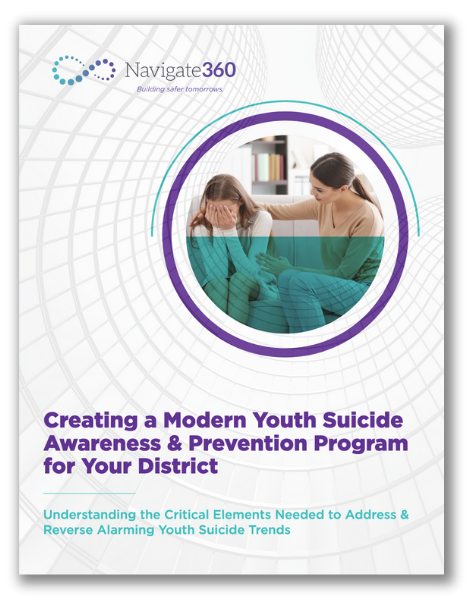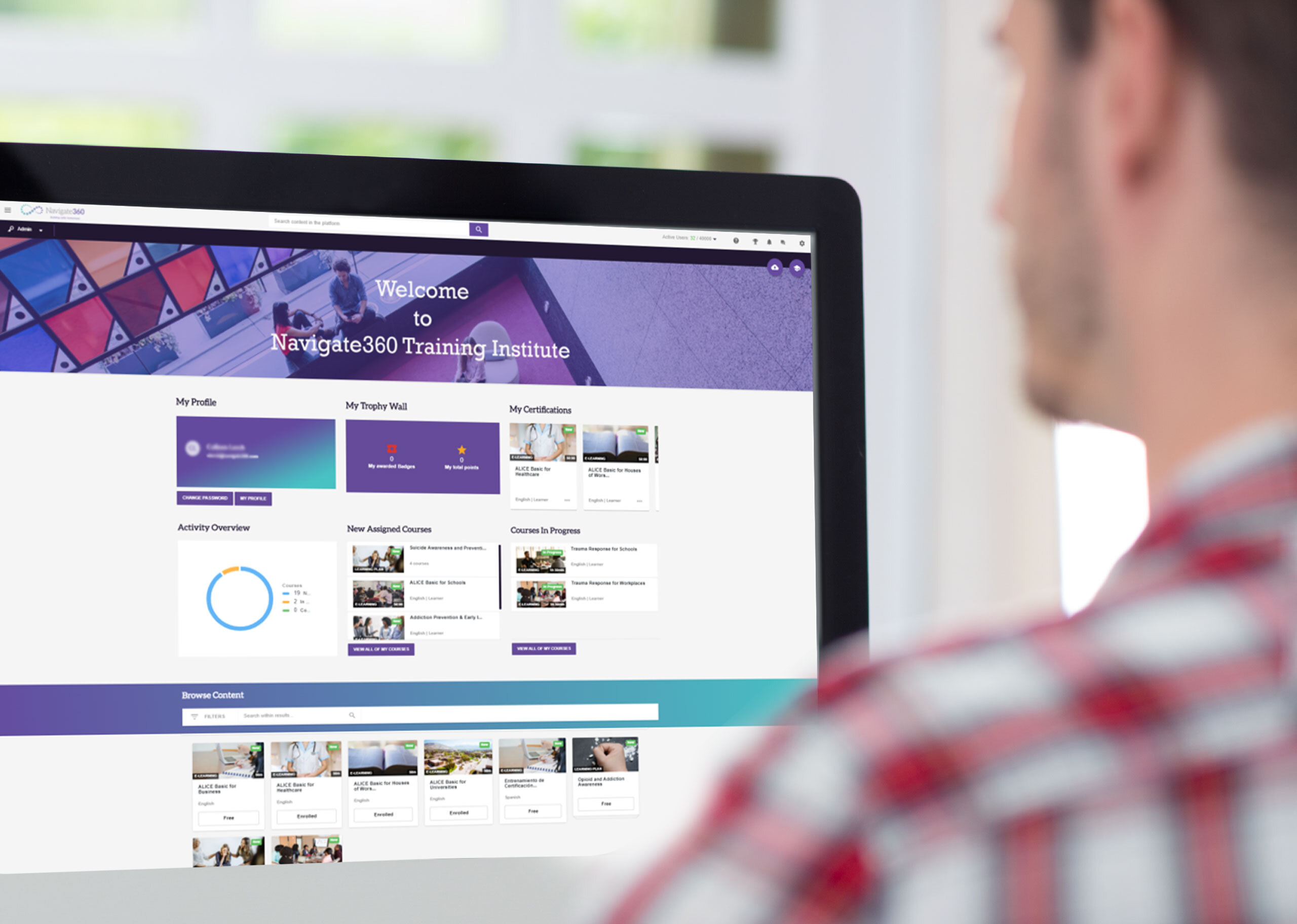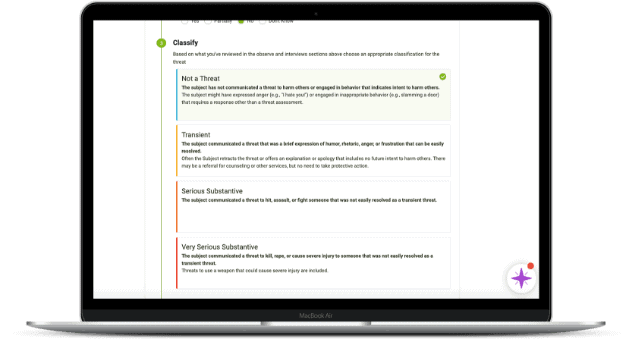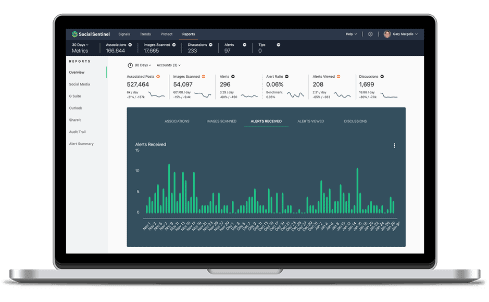Creating a Modern Youth Suicide Awareness & Prevention Program for Your District
Understanding the Critical Elements Needed to Address & Reverse Alarming Youth Suicide Trends Download the GuideIntroduction
When it comes to increased rates of youth suicide and suicidal ideation, numbers don’t lie. Since 2007, suicide rates have more than doubled among individuals 10 to 24 years old. The National Vital Statistics Reports collected data about suicide rates among young people, showing that the suicide rate went from 6.8 per 100,000 in 2007 to 10.7 per 100,000 in 2018. That’s an increase of 57.4%. This report also found that 42 states saw significant increases in youth suicide rates, with most seeing an increase between 30 to 60%. In fact, more students are dying by suicide than by cancer, AIDS, birth defects, stroke, pneumonia, the Flu and chronic lung disease combined.
All this data was collected before the COVID-19 pandemic hit, which has had a detrimental effect on students’ lives, thrusting them into remote learning environments and isolating them from friends and family. Sandy Hook Promise runs an anonymous tip reporting system that saw a 12% spike in suicide-related tips in 2020. And more than 70% of the tips reported deal with self-harm or harm to others. With these alarming trends, the need for a modern districtwide suicide awareness, prevention, screening and case management program has never been so vital. What’s more, early identification of students who have ideations about harming themselves or others is a critical part of the process, as it’s at this beginning stage that schools have the best chance to intervene.
This resource discusses how districts can create holistic, sustainable suicide awareness and prevention programs to reverse alarming rates of youth suicide.
What you know could save a life.
Use these links to quickly jump to a specific section within this resource:

Download your free copy of Creating a Modern Youth Suicide Awareness & Prevention Program for Your District.
Why It’s Important for Schools to Implement Suicide Prevention Programs
Schools play a crucial role in youth suicide prevention. While these programs must incorporate parents, caregivers and community members, school personnel spend a lot of time with students during the school year. After all, students essentially spend half the year in school.
A comprehensive suicide prevention program helps schools allocate scarce resources more efficiently and educate more faculty and staff on how to identify and assist students in crisis. A good program combines actionable education and training for staff members with objective, evidence-based screening and case management tools that help educators streamline the assessment process and use overburdened resources most effectively.
Education also helps schools meet state-level initiatives such as The Jason Flatt Act, which mandates that educators complete at least two hours of youth suicide awareness and prevention training every year. Currently, 21 states have passed this act, but more states are sure to get on board as youth suicide prevention continues to grow in importance throughout the nation.
“It’s important that all school personnel know what to look for, what to do, and [how to] work as a team to prevent a student suicide,” says Scott Poland, Ed.D., a nationally certified school psychologist who serves as the director of the Suicide and Violence Prevention Office at Nova Southeastern University. Dr. Poland has partnered with Navigate360 to develop new curriculum, software and education for K-12 schools, including building a new suicide screening and case management solution that utilizes the Columbia-Suicide Severity Rating Scale (C-SSRS).
Featured Expert

Scott Poland, Ed.D.
National Suicide Awareness & Prevention Expert
Dr. Scott Poland is a professor at the College of Psychology and director of the Suicide and Violence Prevention Office at NSU Florida. He is a licensed psychologist and an internationally recognized expert on school safety, youth suicide, self-injury, bullying, school crisis prevention/intervention and threat assessment. Scott partnered with Navigate360 to develop a new suicide screening and case management solution featuring the Columbia Suicide Severity Rating Scale (C-SSRS). He also contributed his subject matter expertise to a robust suicide prevention eLearning program available exclusively through Navigate360.
Click here to access a library of videos in which Dr. Poland discusses schools’ role in youth suicide awareness and prevention.
Key Elements of a Holistic Suicide Awareness, Prevention, Screening & Management Program
Navigate360 has built the most comprehensive suicide awareness, prevention, screening and management programs for school districts nationwide. We brought together nationally renowned thought leaders to solve the challenges listed above and create a solution that addresses the staggering, and devastating, rise in youth suicide and suicidal ideation. Our program includes:
- Suicide awareness & prevention education for all school personnel who interact with students & additional lessons for students
- Case management to confidentially manage the student’s needs & ensure ongoing care
- Proven suicide screening tools (C-SSRS & SAFE-T) to evaluate the severity of suicide risk
- Anonymous tip reporting to collect & manage concerns about students and school personnel
- Ethical, responsible scanning technology for school-owned email, chat & other digital sources to help identify warning signs before they escalate
This program is flexible and can work with the needs of your school district. For example, if you already have a tip reporting system in place but are looking for more comprehensive suicide awareness and prevention education and better case management, we can customize your district’s initiative to complement the services you have or fulfill the services you need.
Let’s dive into each element of a comprehensive suicide awareness and prevention program.
Suicide Awareness & Prevention Education for School Staff
To create an effective suicide awareness and prevention program, training and education for all staff members who interact with students is a must. Conducting regular education on suicide awareness, prevention and intervention can help staff feel confident about how to help students in need. Many educators report thinking they may cause further harm by bringing up the topic of suicide, or they do not know what to do if they have a student showing warning signs of suicide. By providing regular instruction on suicide awareness and prevention and encouraging staff to work as a team and discuss the concerns they’re facing together, everyone can provide better support for students.
Many programs offer the basics but fall short of educating staff on the ways they can truly make an impact. When we empower staff members with the right information, they can confidently identify and approach a student in need.
All employees who interact with students should be educated about the warning signs of suicide. Education for school psychologists, administrators and guidance counselors should also include the following:
- What to do immediately after identifying a student with suicidal intentions
- The entire intervention process, from the initial identification to the postvention phase
- How to conduct a suicide screening
- How to properly notify the parents of a child with suicidal ideations
- How to refer students to community-based suicide assessments & off-campus clinicians
It’s critical that all school personnel work as a team during these interventions and follow school procedures to the letter. This ensures students receive the help they need without bias and that there is support at every step of the process.
Authored by Dr. Scott Poland, an internationally recognized expert on school safety, youth suicide, self-injury, bullying, school crisis prevention/intervention and threat assessment, Navigate360’s Suicide Awareness and Prevention curriculum prepares your staff to identify students in crisis and ultimately prevent suicide. It exceeds state mandates and guidelines for suicide prevention, keeping your school at the forefront of holistic safety measures that can help keep students as safe as possible.

What You Know Could Save a Life
Learn more about Navigate360’s Suicide Awareness & Prevention Curriculum.
Behavioral Threat Assessment Case Management Platform
In order to compassionately and objectively respond to behavioral threats, school personnel must have a consistent process that allows for comprehensive documentation and long-term planning. Without a platform to manage each case, it’s difficult to correctly document each behavioral threat and provide long-term care that follows students through to school re-entry and beyond. It’s also more difficult to ensure all team members are using the same workflow in the same objective way. What’s more, providing thorough reporting and visibility for district-level administrators — who often need to see how behavioral assessments are being handled at a school level as well as at the district level — is much more challenging.

Using a case management platform such as Navigate360’s cloud-based Behavioral Threat Assessment Case Manager to oversee behavioral threat assessments allows for a consistent, documented and transparent process. School personnel can quickly move through each stage without getting bogged down with process questions and can collaborate with team members and outside agencies such as off-campus clinicians who are treating students. These platforms help schools manage cases over time, too, including guiding educators through the school re-entry process and setting up wellness checkpoints.
Suicide Screening to Evaluate the Severity of Suicide Risk
Without a suicide screening tool in place to assess suicide risk within your case management platform, it is difficult to achieve consistency among staff members and schools. Each person will likely have a different definition and way to measure suicide threats. By standardizing the screening using a tool such as C-SSRS, there will be consistency for all school personnel, uniform severity measurements across districts, and alignment with federal guidelines on suicide prevention.
Navigate360’s Behavioral Threat Assessment Case Manager contains suicide screening and management tools that can help schools evaluate how severe a suicide risk is, as threats often fall along a continuum. While some require immediate intervention with an off-campus clinician, for others, school counseling may be enough. Schools should utilize an assessment tool that reduces bias, ensures complete objectivity and follows national guidelines. These tools provide helpful evaluation standards to assess a student’s suicide risk.
Once the screening is complete, a case can be created that allows for ongoing management and support. Additionally, external clinicians can be invited to the case within the system and make updates. The case management process also includes the important step of student re-entry back into the school.
Our product supports two major standards:
- The Columbia-Suicide Severity Rating Scale (C-SSRS), which is a severity screening tool that provides immediate next steps for suicide screening. The C-SSRS is endorsed, recommended, or adopted by the CDC, FDA, NIH, DoD, SAMHSA, World Health Organization and Action Alliance.
- Suicide Assessment Five-Step Evaluation and Triage (SAFE-T), a model that guides clinicians through five steps that address the level of suicide risk in a person and suggests appropriate interventions.
Anonymous Tip Reporting
Students often don’t know what to do or where to turn if they notice a friend in need or are in need themselves. That’s why an anonymous tip reporting system is crucial to any suicide prevention program. It provides a safe, trusted and anonymous place for students to report potential suicide risks and can help facilitate getting help to students in need. Additionally, it can deescalate bullying and/or hate incidences, preventing victims from escalating into self-harm or suicide.
Consider the impact of Sandy Hook Promise’s anonymous tip reporting system that saw a 12% uptick in suicide and self-harm tips in the months after the pandemic hit. These reporting systems are crucial for young people and have led to thousands of interventions with suicidal students.
Navigate360’s P3 Campus Anonymous Tip Reporting software allows students to anonymously share their concerns, including signs of suicide, with those capable of preventing the preventable. This technology is key to keeping a finger on the pulse of a school’s community, allowing individuals to report tips of possible suicidal and other concerning behaviors via a mobile smartphone app, dedicated email address, secure Web-based platform or telephone hotline. Additionally, allowing encrypted two-way communication enables education leaders to ask more questions of tip reporters while keeping these tipsters’ identity anonymous.
Featured Expert

Todd Wagner
Threat Detection & Prevention Expert
“If you want to know what is going on in your school, or what is going on in your community – ask a teenager. They know. I’ve been witness to this over and over and over, thousands and thousands of times. More importantly, pay attention. When you ask a student to share their concerns and they do, you must pay attention.”
Check out this article by Todd Wagner on how schools can use their anonymous tip reporting tool to prevent youth suicide.
Ethical & Responsible Scanning Technology for School-Owned Email & Chat
Today’s students are more digitally savvy than any other generation, and they are more apt to use digital platforms to connect with friends and family. While these online spaces can provide a positive place to develop one’s interests and find acceptance, they can also be rife with cyberbullying, leakage (the act of sharing information of an intent to cause harm) and suicidal ideation. In fact, many students leave hints about their intentions in the conversations they have online. If we listen carefully and respectfully, we can hear those cries for help before they escalate into violence — to self or to others.
Without software to scan for alarming language, schools would have to take this on manually. That’s a tall order for schools that are already stretched thin on resources and can lead to missed signals and leakage that goes unreported.
Navigate360’s email scanning technology can be an invaluable tool for school districts. It provides ethical, responsible scanning of school-owned email, chat and other digital sources while taking measures to protect and respect the privacy of students and school personnel. It has been shown to help identify bullying, suicidal ideation and violent intentions to help schools provide swift intervention. School districts have a responsibility to know what is being shared on school-owned platforms, and they are held accountable within their communities for the information shared. Ethical and responsible scanning technology ensures districts can live up to these standards.


Discover the Power of Proactive Detection
Navigate360’s email scanning technology is an intuitive platform that can process billions of digital conversations using AI technology. With this in place, schools can keep up with harmful language across digital platforms to provide better support for their students.
We are constantly updating our AI linguistics engine to find leakage even as we scan digital content for harmful language.
Conclusion
Schools have a crucial role to play in supporting students who are anxious, depressed or in a mental health crisis. Having a modern, holistic suicide awareness, prevention, screening and management program is critical to ensuring students know where to turn when they need help or how to help classmates who are in need.
A flexible approach to identifying and addressing student mental health crises is critical in this day and age. You may already have a tip reporting system in place, but you might not know what to do with those tips to make sure students who exhibit concerning behavior remain safe. Navigate360’s program empowers school personnel to better understand the signs of suicidal ideation and other concerning behaviors and know exactly how to help students quickly and effectively. Our suite of preventive safety solutions provides comprehensive support for administrators, educators, students and families. We can customize your school district’s program to complement the services you have or add the services you need as well.
Youth suicide is an urgent crisis, and schools have a responsibility to their students to provide suicide awareness, mental health support and crisis intervention. Without putting critical suicide prevention programs in schools, youth suicide will only continue to rise. There is no time to waste: Students’ lives are at risk.
To learn more about how to build a holistic suicide awareness, prevention, screening and management program in your school district, contact us today.
If you or someone you know might be at risk of suicide, call the National Suicide Prevention Lifeline at 800-273-8255 or visit their website for additional information. You can also text HOME to 741741 to connect with the Crisis Text Line.
Getting Started with Youth Suicide Awareness & Prevention
Contact us today to learn more about our comprehensive suicide awareness and prevention solutions for schools.
